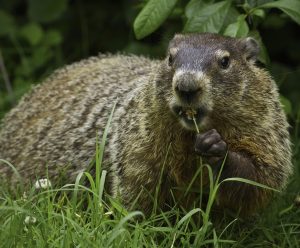Scientific Name: Marmota monax
Common Names: Groundhog, Woodchuck, Whistlepig, Marmot
Color: Brown/Grey
Weight: Approx. 10lbs.
Length: 16 – 20 inches
FACT: Groundhog Day is a common tradition in Canada and the USA, people gather around to watch the rodent predict if there will be an early spring. Evidence has shown that Groundhogs are wrong in their predictions more often than they are right.
HABITS
Groundhogs are the largest member of the squirrel family and live on average to about 3 years in the wild. Even though they are large in size, they have proven to be excellent swimmers and tree climbers. When groundhogs are distressed they will emit a high-pitched whistle, to warn others of danger, hence the nickname ‘whistlepig’.
- Feeding: Groundhogs eat crops, grasses, and berries. They may also eat insects, grasshoppers, snails, or grubs.
- Hibernation: Groundhogs will often build a separate burrow just for winter hibernation. This burrow is dug below the frost line and remains in an above freezing temperature all winter. Typically, groundhogs will hibernate from October to March or April.
- Burrows: Groundhogs are excellent burrowers and will create burrows for sleeping in, raising young, and hibernation. Burrows will have 2 – 5 entrances (approx. 6-8” in diameter) providing the animal with many escape routes when dealing with predators. Burrows can be very large and cause damage to structures.
- Reproduction: Breeding season is March to April. Mated pairs remain together for the 31-day gestation period, once the young a born the male groundhog will leave the den. A female groundhog will have one litter a year, each with approximately 2-6 young.
CONTROL
Groundhogs can be controlled with live traps and exclusion measures.
- Live Trapping is an environmentally safe and humane way to deal with groundhogs. Use gloves while placing and baiting the trap your scent is not left lingering. Bait the trap and cover with some bush to camouflage.
- Exclusion is an environmentally safe and humane way to help prevent groundhogs from coming onto your property. Groundhogs are great climbers, but a good fence will help make it a lot harder for groundhogs to wander into your yard. Fencing should extend at least 1-foot underground to ensure groundhogs will not burrow underneath.
If you find yourself with a groundhog problem, we can help! Poulin’s has seven store locations throughout Western Canada. Our technicians can control these rodents early in the spring before the new litters of 2 – 6 young come out of the burrows in approximately April / May. Once you see them give us a call.

